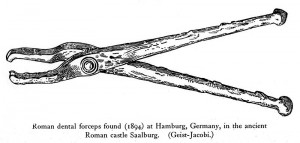 Although every dentist tries to give their patients the most comfortable and pain-free experience possible, we’re well aware that going to the dentist isn’t easy for everyone. Well, it certainly wasn’t painless for our early ancestors, either. From the wild treatments to less than comfortable procedures, we’ve culled 5 fascinating facts about early dentistry that might just make your next appointment feel like a breeze in comparison.
Although every dentist tries to give their patients the most comfortable and pain-free experience possible, we’re well aware that going to the dentist isn’t easy for everyone. Well, it certainly wasn’t painless for our early ancestors, either. From the wild treatments to less than comfortable procedures, we’ve culled 5 fascinating facts about early dentistry that might just make your next appointment feel like a breeze in comparison.
1. It was once believed that in order to make a tooth come out, one should apply either dried crow’s dung or the fat of a green frog. Apparently these substances were thought to be so powerful that they’d not only cause the tooth to fall out, it would apparently fall out instantly. But, in case one accidentally ingested these substances, no fear: you could then rub the brains of a rabbit on your gums and the teeth would grow right back.
2. Dental bridges have existed sine at least 2500 BC in Egypt. They were apparently quite adept at this process — fine holes were drilled through the teeth and a fine gold wire was used to attach the middle replacement tooth to the natural teeth on either side. The replacement tooth was also a natural tooth, but whose, we wonder? Was it the tooth that fell out of the owner’s mouth, or an animal tooth?
3. The ancient Greeks were also adept at using wires for a variety of dental procedures to stabilize the teeth and jaws. They also cauterized teeth and gums with red hot wires — though it’s unclear if any kind of sedation or numbing agent was used. We hope, at least, patients were able to take a good swig of wine before the procedure.
4. Early man actually didn’t have to worry too much about cavities, due to a great lack of sugar in his diet. However, a diet of coarse, rough, and difficult to chew plants and animal meats meant teeth would wear down quickly and severe — down to the pulp, in many cases. This meant that, unfortunately, early man did suffer from toothaches.
5. In the ancient Arabic world, a great emphasis was placed on keeping the teeth clean and thereby prevented the need for dental surgery or extraction. The Koran prohibited any kind of “mutilation” of the body, which made any kind of surgery quite rare. Many kinds of brush-like tools and scrapers have been found, along with recipes for mouthwashes and soothing salves for the gums.
Pretty incredible, huh? Although dentistry has made enormous strides over the ages, we have to admit that our early ancestors were pretty innovative in the ways they treated everything from toothaches to extractions. Of course, we’re more than happy to stick with our modern procedures and equipment — and Novocain!
Resources:
Guerini, V. 1909. A History of Dentistry from the Most Ancient Times Until the End of the Eighteenth Century. National Dental Association: Philadelpia and New York: Lea & Febinger. p. 121-22, 124, 128-129, 141.
Harris JE, Pontiz PV, Ingalls BK. 1998. “Dental Health in Ancient Egypt.” Mummies, Disease and Ancient Culture. Cockburn TA, Cockburn E, Reyman TA eds. Cambridge: Cambridge University Press. p.65
Hiremath SS. 2011. Textbook of Preventive and Community Dentistry. Elsevier India. p.132-133.
Wynbrand J. 2000. The Excruciating History of Dentistry: Toothsome Tales & Oral Oddities from Babylon to Braces. New York: St. Martin’s Griffin. p. 4.
Image courtesy of the Wellcome trust.







Leave a Reply